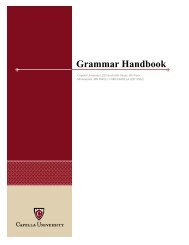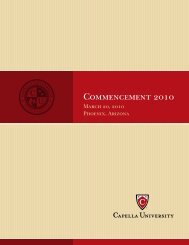Developing an Annotated Outline - Capella University
Developing an Annotated Outline - Capella University
Developing an Annotated Outline - Capella University
You also want an ePaper? Increase the reach of your titles
YUMPU automatically turns print PDFs into web optimized ePapers that Google loves.
<strong>Developing</strong> <strong>an</strong> <strong>Annotated</strong> <strong>Outline</strong><br />
The word “<strong>an</strong>notation” refers to adding information, usually comments,<br />
expl<strong>an</strong>ations, or references<br />
An <strong>an</strong>notated outline, then, would be <strong>an</strong> outline to which additional information is<br />
added, also known as <strong>an</strong>notations. Information included in the <strong>an</strong>notations is<br />
determined by the purpose of the <strong>an</strong>notated outline.<br />
Not all <strong>an</strong>notated outlines are alike<br />
The preparation of the <strong>an</strong>notated outline is governed by the nature of a larger course<br />
project <strong>an</strong>d the role that the <strong>an</strong>notated outline plays in the context of the course as a<br />
whole. In some cases, the <strong>an</strong>notations are expected to consist of<br />
• comments or expl<strong>an</strong>ations<br />
• citations of sources appropriate to each outline entry<br />
• information about each of the cited sources<br />
• topic sentences<br />
This outline is not <strong>an</strong>notated.<br />
Some examples<br />
I. Tr<strong>an</strong>sforming chaos into order<br />
A. Definitions of chaos <strong>an</strong>d order<br />
One way to add <strong>an</strong>notations: adding citations of sources.<br />
I. Tr<strong>an</strong>sforming chaos into order<br />
Arling, T.J., (2006). Underst<strong>an</strong>ding order <strong>an</strong>d chaos. New York: Wylie <strong>an</strong>d<br />
Sons.<br />
Carling, A.B. (2006). Chaos <strong>an</strong>d you. Boston: Prentice Hall.<br />
A. Definitions of chaos <strong>an</strong>d order<br />
Palova, X.R. (2005). Toward a typology of typologies. Journal of<br />
Thinking, 23(2), 176-201.<br />
Caldorone, M.C. (2006). Chaotic concepts. Thinking <strong>an</strong>d learning.<br />
15(3), 1-2.<br />
<strong>Capella</strong> <strong>University</strong> Writing Center<br />
May 2007
Another way to add <strong>an</strong>notations: adding additional information about each of<br />
the sources.<br />
I. Tr<strong>an</strong>sforming chaos into order<br />
Arling, T.J., (2006). Underst<strong>an</strong>ding order <strong>an</strong>d chaos. New York: Wylie <strong>an</strong>d<br />
Sons.<br />
Arling provides a broad overview of the relationship between ordered <strong>an</strong>d<br />
unordered systems. Included in this overview is a discussion of how the<br />
contrast between these systems has affected scientific thought over the past<br />
200 years.<br />
Still <strong>an</strong>other way to add <strong>an</strong>notations: adding complete sentences, with each<br />
sentence usable as a topic sentence for a paragraph in a project or paper.<br />
I. Tr<strong>an</strong>sforming chaos into order<br />
Arling, T.J., (2006). Underst<strong>an</strong>ding order <strong>an</strong>d chaos. New York: Wylie <strong>an</strong>d<br />
Sons.<br />
The contrast between ordered <strong>an</strong>d unordered systems – order <strong>an</strong>d chaos –<br />
has affected scientific thought over the past 200 years.<br />
Import<strong>an</strong>t!<br />
If you have <strong>an</strong>y questions regarding the expectations of <strong>an</strong> <strong>an</strong>notated outline:<br />
• read the assignment description<br />
• review the grading checklist provided in the course<br />
• ask your instructor<br />
<strong>Capella</strong> <strong>University</strong> Writing Center<br />
May 2007








